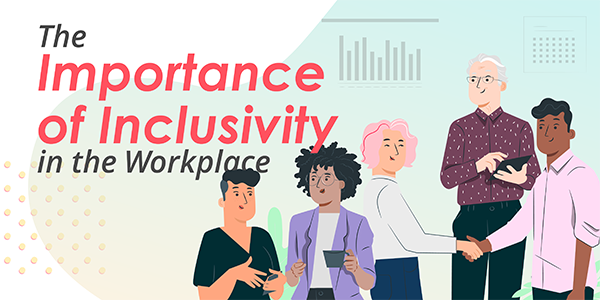
Workplaces today are becoming more diverse. Many companies are making efforts to create a more inclusive culture, and various sectors in society are now being provided the same job opportunities, which were not prevalent ten years ago.
While what an inclusive workplace looks like varies from company to company, it often involves hiring a diverse cross-section of employees. It’s also a different story when you start working for a company. You’ll want to see how seriously it sees inclusivity regarding leadership positions, challenging tasks, and recognition and appreciation.
So, what makes for a genuinely diverse and inclusive workplace? This infographic will break down what exactly inclusivity in the workplace is and how companies today can achieve that.

The Importance of Inclusivity in the Workplace
When employees feel they belong in the company, they become more positively engaged. In other words, a non-inclusive workplace is where employees don’t feel safe, valued, and welcomed, resulting in low performance.
A Deloitte article on diversity and inclusion finds that “diverse and inclusive teams are more innovative, engaged, and creative in their work.” Moreover, diverse and inclusive teams outperform their peers. Inclusion in the workplace is crucial for any organization aiming to foster a strong sense of connection and positive culture. And as you know, a happy and delighted workforce brings success to the company.
Below are a few fast facts and figures that will encourage you to incorporate and embrace inclusivity in the workplace.
- Around 61% of employees believe diversity and inclusion strategies in the workplace are beneficial and important.
- Organizations with inclusive talent practices in hiring, promotion, development, leadership, and team management get up to 30% higher revenue per employee and increased profitability than their competitors.
- About 48% of employees believe that respect is the most important factor for a culture of inclusion.
- Women-led organizations have been shown to produce three times the returns compared to companies predominantly run by men.
Creating a truly diverse and inclusive workplace can be challenging, but it’s not impossible. Give platforms for your employees to use their voices, invite them to participate in decision-making processes, provide their needs to work efficiently and productively, and acknowledge their work to make them feel valued and one within the company.
More Tips to Shape an Inclusive Workplace
- Start at the top
Employees follow and are influenced by company role models. To encourage and value diversity and inclusivity in your company, the people at the executive level must champion these values. You can let C-level executives and team leaders attend seminars to enlighten them about inclusion and understand its importance.
Your C-suite executives must provide equal treatment of employees, including in opportunities and pay. When these people promote awareness and best practices to create a comfortable work environment, everyone else in the organization will follow.
- Connect inclusion to employee engagement
Diverse and inclusive working environments have one thing in common that they do right: employee engagement. This business imperative aims to build a sense of belonging for employees and a positive culture in organizations.
- Amend your recruitment practices as necessary
Review your recruitment method, including your hiring content, practices, how and where you find candidates, interview questions, candidate selection, and performance reviews. There may be unconscious biases existing in your choice of words, hiring qualifications, and procedure.
For instance, you may be unconsciously choosing candidates with similar backgrounds and education, excluding underrepresented groups and narrowing your talent pool. To improve your hiring process, you can involve diverse people in the interview panel to get valuable feedback and perspective.
- Set up initiatives focused on inclusivity
For events, seminars, and other employee engagement activities, ensure that your organization supports and promotes inclusivity and diversity to cater to all your employees from different walks of life. For instance, you can invite guest speakers who can discuss diverse topics, celebrate Pride Month, educate employees about gender sensitivity, and more.
- Model inclusive language
Language plays a huge role in nurturing a company culture where all employees feel included. Better language practices can eliminate misunderstandings and improve employee relationships. Turn your “that’s not what I meant” conversations into more productive discussions. Here are some examples:
- Use affirmative terms instead of negative terms, which you may be unaware of (i.e., use “people with disabilities” instead of “the handicapped” and “person who uses a wheelchair” instead of “wheelchair-bound” or “confined to a chair”).
- Use gender-neutral and inclusive terms whenever possible (i.e., “people” in place of “ladies and gentlemen,” “teammates” in place of “guys,” and “underrepresented” in place of “minorities”).
- Establish safe spaces
Think about the needs of your employees. Apart from quiet workspaces for overstimulated or distracted employees in open floor plans, consider setting up lactation rooms for new mothers, gender-neutral restrooms for non-binary and genderqueer employees, prayer or meditation spaces, and more.
For companies who switched to remote working, you can establish digital safe spaces by encouraging employees to add their pronouns in their usernames or reserving time for prayer. Employees may not feel confident about advocating for their beliefs and causes, so work with managers to learn more about their team’s needs.
- Ensure your office is accessible for people with disabilities
If you have employees with physical disabilities, make sure that your workplace accommodates their needs. For instance, for employees who use a wheelchair, ensure that the office is wheelchair-accessible, meaning there are no mobility obstacles. If your company currently practices remote working, allocate a budget to provide them with the tools they need to work comfortably at home.
- Create opportunities for conversation
How well do your employees know about their colleagues? No matter how many employee engagement activities you set up or town hall meetings you conduct, there’s nothing more encouraging to display your employees’ authentic selves by hosting engagement activities in a more casual setting.
An example would be company-wide lunches where everyone is encouraged to stop working and focus on eating on a table shared with other employees. You can also set up happy hours and cross-team activities to promote a culture of inclusivity for people to get around and chat.
- Ask your employees
There’s no one-size-fits-all approach to workplace diversity and inclusivity programs, so talk to your employees and listen to them. You can suggest initiative ideas and let them choose, or ask for their own input. The goal is to figure out how you can build a better work environment for your employees.
Inclusivity is a Core Competency
When you commit to improving your company by incorporating inclusivity in your core values—creating a culture of safety and acceptance—everyone wins. You get more satisfied employees doing the job they enjoy and get results for your company.
Inclusivity and diversity are not just an afterthought, and there’s no excuse for not putting them in your recruitment strategy and employee engagement.
If you need a hand at improving your hiring process, Manila Recruitment is a recruitment agency in the Philippines that can assist you in building your core team with inclusivity in mind.













